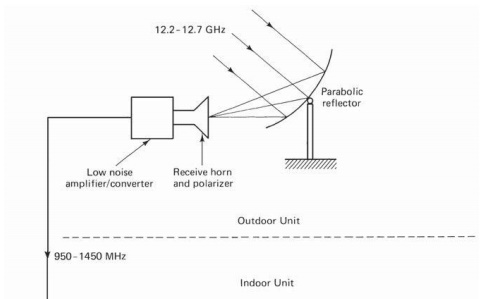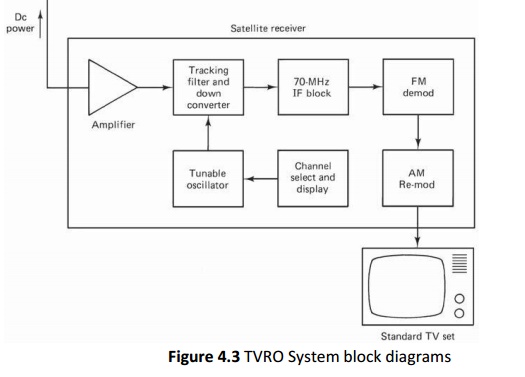Chapter: Satellite Communication : Earth Segment
Receive-Only Home TV Systems
Receive-Only
Home TV Systems:
Planned
broadcasting directly to home TV receivers takes place in the Ku (12-GHz) band.
This service is known as direct broadcast satellite (DBS) service.
There
is some variation in the frequency bands assigned to different geographic
regions. In the Americas, for example, the down- link band is 12.2 to 12.7 GHz.
The
comparatively large satellite receiving dishes [ranging in diame- ter from
about 1.83 m (6 ft) to about 3-m (10 ft) in some locations], which may be seen
in some “backyards” are used to receive downlink TV signals at C band (4 GHz).
Originally
such downlink signals were never intended for home reception but for network
relay to commercial TV outlets (VHF and UHF TV broadcast stations and cable TV
“head-end” studios).
1. The Indoor
unit:
Equipment
is now marketed for home reception of C-band signals, and some manufacturers
provide dual C-band/Ku-band equipment. A single mesh type reflector may be used
which focuses the signals into a dual feed- horn, which has two separate
outputs, one for the C-band signals and onefor the Ku-band signals.
Much
of television programming originates as first generation signals, also known as
master broadcast quality signals.
These
are transmitted via satellite in the C band to the network head- end stations,
where they are retransmitted as compressed digital signals to cable and direct
broadcast satellite providers.
Another of the advantages, claimed for home C-band systems, is the larger number
of satellites available for reception compared to what is available for direct
broadcast satellite sys- terms.
Although many of the C-band transmissions are scrambled, there are free
channels that can be received, and what are termed “wild feeds.”
These are also free, but unannounced programs, of which details can be found in
advance from various publications and Internet sources.
C-band users can also subscribe to pay TV channels, and another advantage
claimed is that subscription services are cheaper than DBS or cable because of
the multiple-source programming available.
The most widely advertised receiving system for C-band system appears to be
4DTV manufactured by Motorola.
This
enables reception of:
Free, analog signals and “wild feeds”
VideoCipher ll plus subscription services
Free DigiCipher 2 services
Subscription DigiCipher 2 services


2. The outdoor
unit:
This
consists of a receiving antenna feeding directly into a low-noise
amplifier/converter combination. A parabolic reflector is generally used, with
the receiving horn mounted at the focus. A common design is to have the focus
directly in front of the reflector, but for better interference rejection, an
offset feed may be used as shown.
Comparing
the gain of a 3-m dish at 4 GHz with a 1-m dish at 12 GHz, the ratio D/l equals
40 in each case, so the gains will be about equal. Although the free-space
losses are much higher at 12 GHz compared with 4 GHz.
The
downlink frequency band of 12.2 to 12.7 GHz spans a range of 500 MHz, which
accommodates 32 TV/FM channels, each of which is 24-MHz wide. Obviously, some
overlap occurs between channels, but these are alternately polarized left-hand
circular (LHC) and right-hand circular (RHC) or vertical/horizontal, to reduce
interference to accept- able levels. This is referred to as polarization
interleaving. A polarizer that may be switched to the desired polarization from
the indoor con- trol unit is required at the receiving horn.
The
receiving horn feeds into a low-noise converter (LNC) or possibly a combination
unit consisting of a low-noise amplifier (LNA) followed by a converter.
The
combination is referred to as an LNB, for low-noise block. The LNB provides
gain for the broadband 12-GHz signal and then converts the signal to a lower
frequency range so that a low-cost coaxial cable can be used as feeder to the
indoor unit.
The
signal fed to the indoor unit is normally a wideband signal cov- ering the
range 950 to 1450 MHz. This is amplified and passed to a tracking filter which
selects the desired channel, as shown in Fig.
As
previously mentioned, polarization interleaving is used, and only half the 32
channels will be present at the input of the indoor unit for any one setting of
the antenna polarizer. This eases the job of the tracking filter, since
alternate channels are well separated in frequency.
The
selected channel is again down converted, this time from the 950- to 1450-MHz
range to a fixed intermediate frequency, usually 70 MHz although other values
in the very high frequency (VHF) range are also used. The 70-MHz amplifier
amplifies the signal up to the levels required for
The
70-MHz amplifier amplifies the signal up to the levels required for
demodulation. A major difference between DBS TV and conventional TV is that
with DBS, frequency modulation is used, whereas with conventional TV, amplitude
modulation in the form of vestigial single side- band (VSSB) is used.
The
70-MHz, FM intermediate frequency (IF) carrier therefore must be demodulated,
and the baseband information used to generate a VSSB signal which is fed into
one of the VHF/UHF channels of a standard TV set.
Related Topics